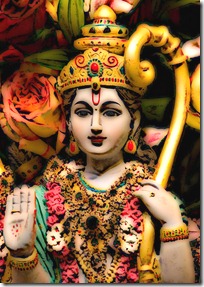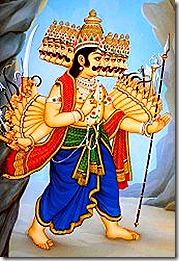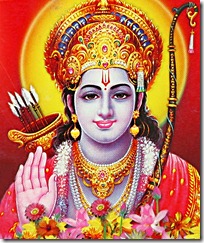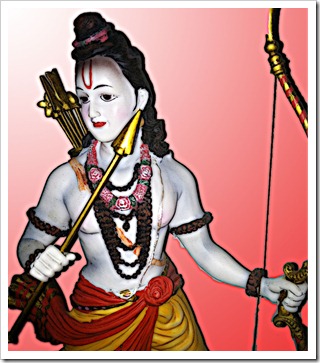, Yuddha Kand, 108.34)
sa tu nihataripuh sthirapratijñaḥ |
svajanabalābhivṛto raṇe rarāja |
raghukulanṛpanandano mahujā |
stridaśagaṇairabhisaṃvṛto yathendraḥ ||
knows it. Shri
Hanuman
is firmly aware of it as well, as he remains alive in the manifested realm just so that he can regularly remember it, finding the most wonderful pleasure simply by bringing it to the forefront of his consciousness. Agastya Rishi, the jar-born Vedic seer, whose piety is so strong that the vilest rogues and thieves cannot even approach his hermitage, knows it as well.
Sita Devi
, the daughter of King Janaka, is the most intimately familiar with it, and the three youngest sons of King Dasharatha of Ayodhya are so in knowledge of it that their very lives revolve around it. Shrila Narada Muni sings about it wherever He goes, and the Vedas have celebrated it in their countless hymns and prayers since time immemorial. On the day that gave Dussehra its real meaning, close friends, allies, and even direct enemies got to witness it personally. As He did that day, the lord of creatures, the Supreme Personality of Godhead, protects His devotees, no matter what size or shape they come in and no matter what their plight may be. Whoever should be harassing them and whatever condition the Lord personally finds Himself in, His promise to protect the saints from danger, to deliver them from the calamities caused by the influence of miscreant characters like Ravana, never breaks. On Dussehra, we remember the time when
Lord Rama
, the Supreme Lord in His form as a warrior prince, was honored and worshiped for His dedication, when His friends rejoiced in His victory, the one that didn’t seem possible.

Was the victorious outcome ever in jeopardy? Shouldn’t God be capable of handling any situation? How can God’s strengths ever be doubted? Does not the sun rise and set every day? Is not the earth humbled by earthquakes, the moon by eclipses, and the living entities by the threefold miseries of life? Knowing that these occurrences are regular, how can anyone think that another person could be inferior or supremely feared? Forgetfulness is one of the defects borne of the propensity to commit mistakes that is found within every human being. Couple this tendency with the influence of time, material nature’s most powerful agent for change, and it’s not surprising that man would forget about his own fallibility. Moreover, man even forgets that the defects and pains he encounters in his own life apply to everyone else as well. For these reasons, a powerful Rakshasa during the Treta Yuga was feared to be the most powerful ruler in the world, someone who could never be stopped.
Lost in the immediate aftermath of this fiend’s reign of terror was the fact that none of his abilities were acquired through his own effort. Ravana was the product of the union between a Rakshasa mother and a brahmana father. A brahmana by quality and work is a person with saintly qualities, someone who is nonviolent, cool-headed, kind and extremely knowledgeable. The brahmana is considered intelligent because he uses whatever information is fed into the computer that is the mind to further the highest aim of life, that of becoming God conscious. A smart person isn’t necessarily someone with a high IQ or someone who knows a lot of facts. True intelligence is marked by the ability to utilize whatever information is gathered to further a specific desire. As everyone is born ignorant, all knowledge comes through acquisition. In this sense it’s difficult to make comparative assessments of knowledge gathering abilities, for we don’t say that one person is better at eating than another person. Whether it takes us a long time to acquire information or a short time, the fact that we have to accept information from external sources shows that every one of us is flawed.
Intelligence is determined by how the information absorbed is used. Brahmanas possess the most valuable knowledge, because they know that the living beings are Brahman, or pure spirit. Therefore not only is every human being equal in their constitution, but so is every living entity, from the tiny ant all the way up to the denizens of heaven, the celestial figures that are in charge of the various departments of the material creation. The correct Sanskrit term is dehinam, or embodied, to describe the condition of the sparks of Brahman that roam the material land in different body types.
“That knowledge by which one undivided spiritual nature is seen in all existences, undivided in the divided, is knowledge in the mode of goodness.” (Lord Krishna,
Bhagavad-gita
, 18.20)

A brahmana surveys everything with an equal vision acquired through austerity, penance and sacrifice. These activities are taken up with a purpose; to remain tied to the Supreme Lord, the origin of Brahman. A Rakshasa, on the other hand, is not very intelligent. They delight in eating animal flesh, including human carcasses, and drinking wine incessantly. Both the spiritualist and the drug addict are looking to escape the influence of the senses that is concomitant with an embodied existence, but the addict finds an illusory escape, one which only sharpens the fangs of the dangerous material senses. The spiritualist, on the other hand, follows authorized methods passed down in the Vedas, the ancient scriptures of India, to remove the teeth from the serpent-like senses. Thus both persons can appear to be exactly the same on the outside, with one feeling perpetual misery from being constantly bitten, while the other lives peacefully in full knowledge of their constitutional position and the spirit soul’s superiority over the material energy.
How did a Rakshasa and a brahmana produce a son then? The sage Vishrava was engaged in meditation when he was interrupted by a Rakshasa woman who wanted to bear a child with him. She was sent to Vishrava by her father for this very purpose, as the Rakshasa clan had just been routed out of the beautiful island of Lanka. Vishrava was angered over having his meditation broken, so he cursed the woman to get her wish. She would get a son through him, but that child would be the vilest creature around. When the time of birth came, this son emerged with a ghastly visage having ten heads. He was thus known by names such as Dashanana and Dashagriva.
His influential powers came later on when he propitiated the first created living entity, Lord Brahma. Dashagriva’s mother saw that Kuvera, her husband’s son begotten through a different woman, was living very opulently due to benedictions he received from the
demigods
. Therefore she wanted her sons to have the same abilities. She instructed her sons Dashanana, Kumbhakarna and Vibhishana to perform austerities to please Lord Brahma. Kumbhakarna had a slip of the tongue and mistakenly asked for the benediction to be able to sleep for months at a time, while Vibhishana asked to be devoted to piety. Dashanana received amazing strength, invincibility in battle against seemingly every type of creature. He made the mistake of not asking for immunity from human beings. This would cost him later on.

Using his powers for evil, Dashanana went on a reign of terror. After pleasing
Lord Shiva
, the Rakshasa received the name Ravana, which means one who has a terrorizing roar. Things got so bad because of Ravana’s work that the saintly class started worrying that maybe the world had been turned over to evil for good. The rishis residing in the forests not bothering anyone would have their sacrifices interrupted by Ravana and his Rakshasas congregated in Lanka. They would do more than just disrupt the religious practices of the saints. They would kill the saints and then eat their flesh. In this way Ravana proved to be the vilest of creatures, the worst of the worst. The demigods finally petitioned
Lord Vishnu
, the Supreme Lord in His personal form, to come to earth and deal with the situation. He would descend as a human being so that Ravana would be killed while the boons granted to him by Brahma would stay protected.
God would appear on earth as Lord Rama, the noble, handsome, pious, kind, and dedicated eldest son of the King of Ayodhya, Maharaja Dasharatha. True to his nature, Ravana would find a way to bother even Rama, though the Lord never bothered anyone.
Lakshmana
, Rama’s younger brother, once remarked that even the people punished by Rama could not find fault in Him. This was because they knew that Rama did not play favorites when administering justice, that He never unjustly punished any person. This fact made Ravana’s act of taking away Rama’s wife Sita all the more vile.
Rama couldn’t be defeated by Ravana’s 14,000 attacking Rakshasa warriors sent to the forest of Dandaka, and neither would the Lord remain on the sidelines when His wife went missing. Ravana took Sita away through a backhanded plot, which ironically sealed his doom at the same time. Sita’s kidnap gave Rama the excuse needed to take on Ravana and thus satisfy the desire of the saintly class. Even with Rama’s amazing mastery of archery, His ability to shoot arrows that were like nuclear weapons in strength, there was still some doubt as to the final outcome; such is the nature of embodied living. We know that life will go on after a particular sporting event takes place, but we still get nervous during the critical moments when watching. The air of uncertainty is always there in a land where birth and death take place in repeating cycles.

The uncertainty in the minds of the nervous onlookers was strengthened by the fact that during the final battle between Rama and Ravana, the demon king seemed to be unbeatable. Rama kept lopping off his many arms and heads, and yet Ravana just kept growing new ones. Such amazing creatures aren’t seen today, so the historical accounts found in the Ramayana may seem like mythology, but as the saints so nicely point out, the wonderful displays of strength and ability from beings in this world are nothing compared to what God can do. Even the Supreme Lord’s personal exhibition of strength represents but a tiny fragment of what He is truly capable of. Therefore it was not that surprising to see Ravana continually regenerate new heads and arms.
Rama’s army consisted of monkeys fighting with rocks and uprooted trees, while Ravana’s army was full of Rakshasas expert in black magic. It didn’t seem like a fair fight, but Rama’s side was winning nonetheless. In the final battle, when it seemed like there was no way that Ravana would be killed, that even Rama couldn’t defeat him, the Lord took out His most powerful arrow, one passed down from Lord Brahma, a weapon that previously belonged to Agastya Rishi.
Chanting
the proper mantras as He drew the arrow to His bow, Rama released the powerful weapon, which marked the culmination of the intense struggle with Ravana, an arrow that allayed the fears of the fighting monkeys, the saintly class of men and the celestials watching from above. Penetrating Ravana’s body, that arrow ended the demon’s life and any chances the Rakshasas had of victory.
After Ravana was slain, Rama’s friends and well-wishers fighting for His side congregated around Him and praised His achievement. The scene was reminiscent of Lord Indra, the king of heaven, being surrounded by the celestial fighters after a victory over the asuras, or demons. Up until this point in time Rama had endured so much for others. He went to the forest for fourteen years to maintain the good name of His father, who had promised two boons to his youngest wife Kaikeyi. Rama took Sita and Lakshmana with Him because they insisted on coming along. The Lord fought 14,000 Rakshasas all by Himself to protect the saints in the forests. The Lord killed the monkey-king Vali so that His friend Sugriva would no longer live in fear. He accepted an estranged Vibhishana into His camp and installed him on the throne of Lanka even before Ravana’s death. He worshiped the sun-god at the behest of Agastya just prior to the final battle with Ravana, and He even took out His most potent arrow only after His charioteer suggested it.
Dussehra is Rama’s day. On that battlefield many thousands of years ago the Lord did away with the most nefarious creature ever to have roamed the sacred earth, and He proved once again that the songs of the Vedas and the words of the saints are not empty, that God
doesprotect those who surrender unto Him in earnest. On Dussehra we remember, honor and cherish Shri Rama in His beautiful form, smiling and holding His bow and arrow. Rama never asks anything from anyone, but if someone is devoted to Him, He promises to stand by them. Because He removes the fears of the devotees, He is known as Hari. Because His name is as powerful as the arrows that fly from His bow, the devotees craving His association regularly chant the holy names, “
Hare Krishna Hare Krishna, Krishna Krishna, Hare Hare, Hare Rama Hare Rama, Rama Rama, Hare Hare
”.
 In Closing
In Closing:
See Rama’s face that is always smiling,
In His hands bow and arrow He is holding.
The saints and the innocent He is protecting,
Their honor and fame always worth defending.
Ravana, he of scream that is terrorizing,
Sacrifices of saints he given to destroying.
Received boons from Brahma, lord of creating,
So that none in battle him would be defeating.
Immunity from all creatures he got from asking,
Would pay the price for human beings forgetting.
In the form of Shri Rama, of beauty logic defying,
Would come Ravana’s doom, end of life approaching.
Through a fierce fight, after many arrows went flying,
Rama released Brahma’s weapon, Ravana’s chest penetrating.
Dussehra is day for Rama’s glories to be celebrating,
Remember the Lord and His entourage through His names chanting.

 “That Rama, the delight of the king of the Raghu dynasty, who had just slayed his enemy and was thus steady in His vow, possessing tremendous might, shone brightly while standing on the battlefield encircled by His army and friends, like Lord Indra surrounded by the demigods.” (
“That Rama, the delight of the king of the Raghu dynasty, who had just slayed his enemy and was thus steady in His vow, possessing tremendous might, shone brightly while standing on the battlefield encircled by His army and friends, like Lord Indra surrounded by the demigods.” ( Was the victorious outcome ever in jeopardy? Shouldn’t God be capable of handling any situation? How can God’s strengths ever be doubted? Does not the sun rise and set every day? Is not the earth humbled by earthquakes, the moon by eclipses, and the living entities by the threefold miseries of life? Knowing that these occurrences are regular, how can anyone think that another person could be inferior or supremely feared? Forgetfulness is one of the defects borne of the propensity to commit mistakes that is found within every human being. Couple this tendency with the influence of time, material nature’s most powerful agent for change, and it’s not surprising that man would forget about his own fallibility. Moreover, man even forgets that the defects and pains he encounters in his own life apply to everyone else as well. For these reasons, a powerful Rakshasa during the Treta Yuga was feared to be the most powerful ruler in the world, someone who could never be stopped.
Was the victorious outcome ever in jeopardy? Shouldn’t God be capable of handling any situation? How can God’s strengths ever be doubted? Does not the sun rise and set every day? Is not the earth humbled by earthquakes, the moon by eclipses, and the living entities by the threefold miseries of life? Knowing that these occurrences are regular, how can anyone think that another person could be inferior or supremely feared? Forgetfulness is one of the defects borne of the propensity to commit mistakes that is found within every human being. Couple this tendency with the influence of time, material nature’s most powerful agent for change, and it’s not surprising that man would forget about his own fallibility. Moreover, man even forgets that the defects and pains he encounters in his own life apply to everyone else as well. For these reasons, a powerful Rakshasa during the Treta Yuga was feared to be the most powerful ruler in the world, someone who could never be stopped. A brahmana surveys everything with an equal vision acquired through austerity, penance and sacrifice. These activities are taken up with a purpose; to remain tied to the Supreme Lord, the origin of Brahman. A Rakshasa, on the other hand, is not very intelligent. They delight in eating animal flesh, including human carcasses, and drinking wine incessantly. Both the spiritualist and the drug addict are looking to escape the influence of the senses that is concomitant with an embodied existence, but the addict finds an illusory escape, one which only sharpens the fangs of the dangerous material senses. The spiritualist, on the other hand, follows authorized methods passed down in the Vedas, the ancient scriptures of India, to remove the teeth from the serpent-like senses. Thus both persons can appear to be exactly the same on the outside, with one feeling perpetual misery from being constantly bitten, while the other lives peacefully in full knowledge of their constitutional position and the spirit soul’s superiority over the material energy.
A brahmana surveys everything with an equal vision acquired through austerity, penance and sacrifice. These activities are taken up with a purpose; to remain tied to the Supreme Lord, the origin of Brahman. A Rakshasa, on the other hand, is not very intelligent. They delight in eating animal flesh, including human carcasses, and drinking wine incessantly. Both the spiritualist and the drug addict are looking to escape the influence of the senses that is concomitant with an embodied existence, but the addict finds an illusory escape, one which only sharpens the fangs of the dangerous material senses. The spiritualist, on the other hand, follows authorized methods passed down in the Vedas, the ancient scriptures of India, to remove the teeth from the serpent-like senses. Thus both persons can appear to be exactly the same on the outside, with one feeling perpetual misery from being constantly bitten, while the other lives peacefully in full knowledge of their constitutional position and the spirit soul’s superiority over the material energy. Using his powers for evil, Dashanana went on a reign of terror. After pleasing
Using his powers for evil, Dashanana went on a reign of terror. After pleasing  The uncertainty in the minds of the nervous onlookers was strengthened by the fact that during the final battle between Rama and Ravana, the demon king seemed to be unbeatable. Rama kept lopping off his many arms and heads, and yet Ravana just kept growing new ones. Such amazing creatures aren’t seen today, so the historical accounts found in the Ramayana may seem like mythology, but as the saints so nicely point out, the wonderful displays of strength and ability from beings in this world are nothing compared to what God can do. Even the Supreme Lord’s personal exhibition of strength represents but a tiny fragment of what He is truly capable of. Therefore it was not that surprising to see Ravana continually regenerate new heads and arms.
The uncertainty in the minds of the nervous onlookers was strengthened by the fact that during the final battle between Rama and Ravana, the demon king seemed to be unbeatable. Rama kept lopping off his many arms and heads, and yet Ravana just kept growing new ones. Such amazing creatures aren’t seen today, so the historical accounts found in the Ramayana may seem like mythology, but as the saints so nicely point out, the wonderful displays of strength and ability from beings in this world are nothing compared to what God can do. Even the Supreme Lord’s personal exhibition of strength represents but a tiny fragment of what He is truly capable of. Therefore it was not that surprising to see Ravana continually regenerate new heads and arms. In Closing:
In Closing: